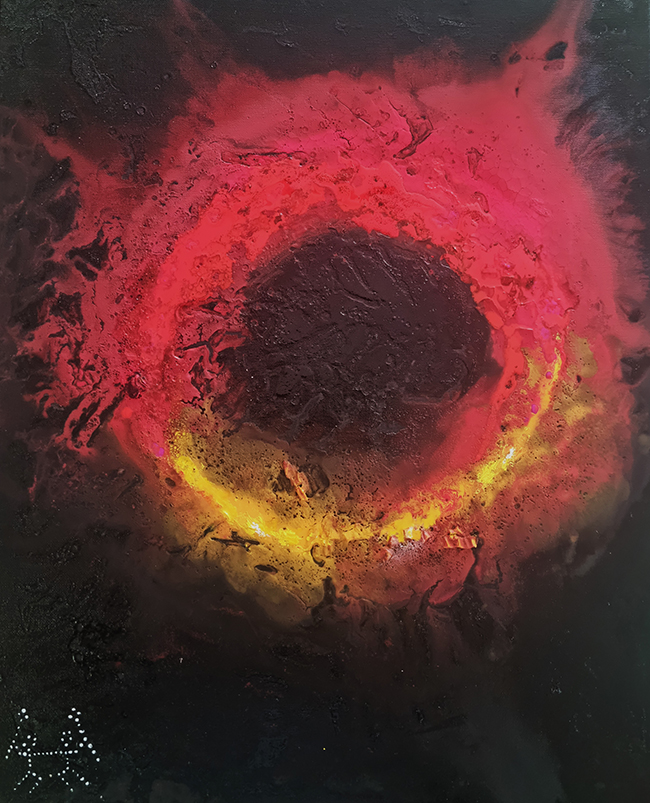Ted Barr’s journey as an artist is as unique as his life story. Born in Nevodar, Romania, near the Black Sea, Barr’s early years were shaped by the waves of immigration, moving to Israel at the tender age of four. This shift set the stage for a life of exploration, not just of the world but of the cosmos and the human condition itself.

In 1975, Barr was drafted into the Israeli army, where he served for 26 years, including as an officer and deputy battalion commander with the rank of Major. His military service, though demanding, didn’t stifle his thirst for knowledge and understanding. In fact, it seems to have intensified it. After his initial service, Barr delved into a decade of study in subjects that would later profoundly influence his art: Symbolism, Buddhism, Ancient Egypt, Numerology, and Kabbalah. These esoteric fields, combined with his M.B.A. in marketing from Tel Aviv University, painted a picture of a man deeply curious about both the outer world and the inner self.
Barr’s formal art education began in 1995, under the tutelage of Israeli master Shlomo Tzafrir in Old Jaffa. It was here that Barr’s artistic voice began to emerge, leading to his first public exhibition in 2001. His art is deeply rooted in concepts that go beyond the visible world, focusing on deep space, celestial elements, and the origins of life. These themes reflect his lifelong fascination with the universe and humanity’s place within it.
Central to Barr’s work is his “Deep Space” series, which draws inspiration from the awe-inspiring images captured by the Hubble and Webb Telescopes. Barr’s fascination with the night sky, the stars, and the mysteries they hold is evident in this body of work. Through his art, Barr asks profound questions about the connections between humans and the cosmos. Are we merely inhabitants of this world, or are we, in some way, intertwined with the very stars that we gaze upon?
This exploration of cosmic themes is not just about distant galaxies and nebulas. For Barr, it’s also about the very beginnings of life—embryos, ovum, and the development of the embryo in the womb. His work is influenced by the microscopic images captured by Swedish photographer Lennart Nilsson, which reveal the intricate beauty of life at its earliest stages. Barr’s art invites viewers to ponder the mysteries of existence, from the vastness of space to the delicate dance of life within the womb.
One of the core philosophies that underpin Barr’s work is encapsulated in the acronym FLY, which stands for “Free the Life within You.” This philosophy is about breaking free from the physical and mental constraints that bind us, allowing us to explore the full potential of our existence. It’s a call to embrace diversity, creativity, and the myriad possibilities that life offers. Barr’s FLY philosophy is not just theoretical; it’s a practical approach to life that he shares through his art, workshops, and lectures around the world.
The FLY philosophy emphasizes the importance of self-expression, stripped of external labels and societal expectations. For Barr, true self-expression comes from the “distilled core of humanity,” an idea that resonates deeply in his art. His workshops, designed to be inclusive and accessible, focus on collaborative creation, where participants from all walks of life come together to explore their creative potential. In these workshops, Barr believes that the convergence of minds and hearts can amplify individual expression, leading to a transformative experience.
Barr’s dedication to spreading the FLY method is evident in all his endeavors. Whether through his art, his writings, or his workshops, Barr seeks to inspire others to embrace the essence of FLY—unity, creativity, openness, and love. His work is not just about creating beautiful images; it’s about encouraging others to explore their own potential, to break free from limitations, and to find joy in the creative process.
In Ted Barr’s art, the cosmos and the human soul are not separate entities but deeply interconnected. His work invites us to look beyond the surface, to question, to explore, and ultimately, to discover the profound beauty of existence—both in the stars above and in the life within us.

